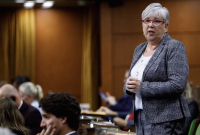Support strong Canadian climate journalism for 2025
The federal government released the broad strokes of its plan to save plummeting wild salmon stocks on the West Coast on Tuesday.
Federal Fisheries Minister Bernadette Jordan outlined the initial framework and guiding principles for Ottawa’s $647.1-million Pacific Salmon Strategy Initiative (PSSI), announced as part of the recent federal budget.
Four key areas form the foundation of the strategy: conservation and stewardship, enhanced hatchery production, harvest transformation, and integrated management and collaboration, Jordan said.
Some B.C. salmon conservationists say the plan’s pillars and funding are positive, but the devil is in the details. Concerns raised include the use of hatcheries, the need to establish recovery plans, ensuring First Nations are true partners in the process, and that the entities steering the process are independent.
“Overall, it’s a positive announcement,” said Aaron Hill, executive director of Watershed Watch Salmon Society.
“We’re cautiously optimistic that it'll move things in the right direction.”
Many wild salmon stocks in B.C. and the Yukon are on the verge of collapse and bold action was necessary to reverse the trend, said Jordan, noting some populations have suffered declines of 90 per cent.
“The challenges facing Pacific salmon are enormous, but they're not insurmountable,” Jordan said.
“With the development of the historic Pacific salmon strategy, we will deploy the resources on a level that meets the scale of the crisis head on, and we will turn the corner.”
The four pillars support a strategic and co-ordinated long-term response rooted in collaborative action, she added.
“This is not a top-down approach,” Jordan said, adding Indigenous peoples, provincial and territorial governments, harvesters, stewardship partners, academia, environmentalists, and other stakeholders will be relied on to execute and guide the strategy.
The plan aims to develop stronger science and habitat restoration, stabilize and grow salmon populations and sustainable and reliable fisheries, as well as deepen communication and co-ordination between partners.
The funding is dedicated to conservation initiatives on the ground, Jordan said, adding the salmon strategy isn’t a new report or study.
Ottawa is partnering with the B.C. government on conservation through the province’s Salmon Restoration and Innovation Fund (BCSRIF) to fund projects on the ground immediately, Jordan said.
In the recent budget, Ottawa committed a further $100 million to the $143-million program.
Fisheries and Oceans Canada (DFO) will also begin planning and consultations to build new hatchery facilities to provide critical assistance for at-risk salmon stocks, Jordan said.
“We're starting work immediately to consult with First Nations and local organizations to determine exactly where these hatcheries should be located to deliver the biggest impact,” Jordan said, adding DFO will take strategic steps to ensure that hatcheries won’t compromise wild fish stocks.
Strategic work with existing hatcheries will enhance their efforts where needed and aim to support economic opportunities for recreational fishers, she added.

Hill expressed concern that using hatcheries to support fisheries will further erode at-risk stocks by reducing the genetic fitness of wild salmon, and would see hatchery fish competing with endangered populations in the marine food web already under increasing duress.
“There is a need for hatcheries in some cases to rescue wild salmon runs from extinction,” Hill said, adding he’s pleased Jordan suggested DFO will take a conservation approach to their use.
“But the best way to do that is through a biological risk-assessment framework — something they currently have — but which is in a bit of a shambles and needs a massive overhaul,” he said.
DFO also urgently needs to develop science-based recovery plans for specific at-risk salmon populations, as required by 2019 changes to the Fisheries Act, Hill said.
Bob Chamberlin, a former vice-president of the Union of B.C. Indian Chiefs and a longtime advocate for wild salmon, said he wants Ottawa to abandon just consulting First Nations and work at a government-to-government level to enact the strategy.
Doing so is particularly relevant as Ottawa undertakes legislative changes to bring Canadian laws in line with the United Nations Declaration on the Rights of Indigenous Peoples (UNDRIP), he said.
“This is one of those vital opportunities to get it right the first time, and create space for First Nations partnerships to develop and implement salmon restoration,” Chamberlin said.
Work is already underway to co-ordinate a First Nation salmon restoration framework in B.C. to identify priorities, he added
“That’s the work I’ve been doing for the past six months. I've talked to First Nations across B.C. and the support is overwhelming.”
As part of the strategy, a federal Pacific salmon secretariat will be developed to caretake and integrate the data collected under the initiative, Jordan said.
A restoration centre of expertise for Pacific salmon will also be created to provide technical expertise to support restoration efforts by salmon stewardship groups.
“This (centre) will break down silos, increase communication, and we will learn from these groups to ensure we are focused in the right direction and the right areas, and adapting as time progresses,” Jordan said.
To be effective, both the proposed secretariat or the centre of expertise shouldn’t be overseen by the DFO, which also regulates salmon farms in B.C. waters and might potentially ignore or suppress science suggesting the operations pose a threat to wild stocks, Hill said.
“The idea of a Pacific salmon secretariat could be a great thing, but I’m concerned it might just be a sort of administrative function within DFO,” Hill said.
“We’d really love to see something that's arm's length.
“I don't think we'll see a good outcome if they're the ones that are also in charge of rolling out this whole initiative and overseeing it.”
Editor’s Note: This story was updated Tuesday evening to include comments from advocates involved in B.C. salmon conservation.
Rochelle Baker / Local Journalism Initiative / Canada’s National Observer







Comments